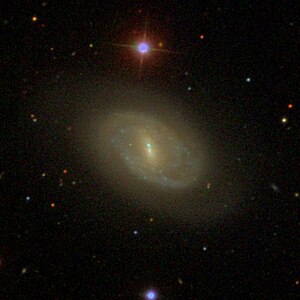NGC 4413
| Galaxy NGC 4407 / NGC 4413 |
|
|---|---|

|
|
| SDSS recording | |
| AladinLite | |
| Constellation | Virgin |
|
Position equinox : J2000.0 , epoch : J2000.0 |
|
| Right ascension | 12 h 26 m 32.2 s |
| declination | + 12 ° 36 ′ 40 ″ |
| Appearance | |
| Morphological type | (R ') SB (rs) from: / HII |
| Brightness (visual) | 11.9 likes |
| Brightness (B-band) | 12.7 mag |
| Angular expansion | 2.3 ′ × 1.4 ′ |
| Position angle | 60 ° |
| Surface brightness | 13.0 mag / arcmin² |
| Physical data | |
| Affiliation | Virgo cluster (?) Holm 403F |
| Redshift | 0.000340 ± 0.000020 |
| Radial velocity | 102 ± 6 km / s |
|
Stroke distance v rad / H 0 |
(2 ± 0) x 10 6 ly (0.65 ± 0.1) Mpc |
| diameter | 35,000 ly |
| history | |
| discovery | Wilhelm Herschel |
| Discovery date | April 17, 1784 |
| Catalog names | |
| NGC 4413 • NGC 4407 • UGC 7538 • PGC 40705 • CGCG 070-076 • MCG + 02-32-049 • IRAS 12239 + 1253 • 2MASX J12263225 + 1236390 • VCC 912 • GC 2968/2974 • H II 169 • h 1255 / 1259 • LDCE 904 NED109 • VPC 472 • EVCC 609 | |
NGC 4407 = NGC 4413 is a bar-spiral galaxy with extensive star formation areas of the Hubble type SBab in the constellation Virgo on the ecliptic . It is estimated to be 2 million light years from the Milky Way and is listed under catalog number VVC 912 as part of the Virgo Galaxy Cluster. The radial speed of NGC 4407 of 105 km / s is too low to provide a reliable indicator of the distance, as particular speeds (without Hubble expansion) could make up a significant part of the value. In fact, the distance of 2 million light years corresponding to its speed is far less than the redshift independent distance estimate of about 51 million light years.
In the same area of the sky are u. a. the galaxies NGC 4388 , NGC 4425 , IC 3349 , IC 3363 .
The object was discovered by Wilhelm Herschel on April 17, 1784 and accidentally recorded twice, so that two entries in the New General Catalog refer to this galaxy.
